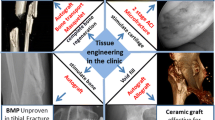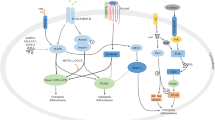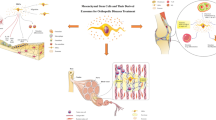Abstract
Growth factors have a pivotal role in chondrogenic differentiation of stem cells. The differential effects of known growth factors involved in the maintenance and homeostasis of cartilage tissue have been previously studied in vitro. However, there are few reported researches about the interactional effects of growth factors on chondrogenic differentiation of stem cells. The aim of this study is to examine the combined effects of four key growth factors on chondrogenic differentiation of mesenchymal stem cells (MSCs). Isolated and expanded rabbit bone marrow-derived MSCs underwent chondrogenic differentiation in a micromass cell culture system that used a combination of the following growth factors: transforming growth factor beta 1 (TGF-β1), bone morphogenetic protein 2 (BMP2), parathyroid hormone related protein (PTHrP), and fibroblast growth factor 2 (FGF2) according to a defined program. The chondrogenic differentiation program was analyzed by histochemistry methods, quantitative RT-PCR (qRT-PCR), and measurement of matrix deposition of sulfated glycosaminoglycan (sGAG) and collagen content at days 16, 23, and 30. The results showed that the short-term combination of TGF-β1 and BMP-2 increased sGAG and collagen content, Alkaline phosphates (ALP) activity, and type X collagen (COL X) expression. Application of either PTHrP or FGF2 simultaneously decreased TGF-β1/BMP-2 induced hypertrophy and chondrogenic markers (at least for FGF2). However, successive application of PTHrP and FGF2 dramatically maintained the synergistic effects of TGF-β1/BMP-2 on the chondrogenic differentiation potential of MSCs and decreased unwanted hypertrophic markers. This new method can be used effectively in chondrogenic differentiation programs.





Similar content being viewed by others
References
Chimal-Monroy, J., & de Leon, L. D. (2003). Differential effects of transforming growth factors beta 1, beta 2, beta 3 and beta 5 on chondrogenesis in mouse limb bud mesenchymal cells. International Journal of Developmental Biology, 41, 91–102.
Sekiya, I., Larson, B. L., Vuoristo, J. T., Reger, R. L., & Prockop, D. J. (2005). Comparison of effect of BMP2,-4, and-6 on in vitro cartilage formation of human adult stem cells from bone marrow stroma. Cell and Tissue Research, 320, 269–276.
Wang, L., & Detamore, M. S. (2009). Insulin like growth factor I improves chondrogenesis of predifferentiated human umbilical cord mesenchymal stromal cells. Journal of Orthopaedic Research, 27, 1109–1115.
Moore, E., Bendele, A., Thompson, D., et al. (2005). Fibroblast growth factor-18 stimulates chondrogenesis and cartilage repair in a rat model of injury-induced osteoarthritis. Osteoarthritis and Cartilage, 13, 623–631.
Handorf, A. M., & Li, W.-J. (2011). Fibroblast growth factor-2 primes human mesenchymal stem cells for enhanced chondrogenesis. PLoS One, 6, e22887.
Lee, J.-M., & Im, G.-I. (2012). PTHrP isoforms have differing effect on chondrogenic differentiation and hypertrophy of mesenchymal stem cells. Biochemical and Biophysical Research Communications, 421, 819–824.
Indrawattana, N., Chen, G., Tadokoro, M., et al. (2004). Growth factor combination for chondrogenic induction from human mesenchymal stem cell. Biochemical and Biophysical Research Communications, 320, 914–919.
Fukumoto, T., Sperling, J., Sanyal, A., et al. (2003). Combined effects of insulin-like growth factor-1 and transforming growth factor-β1 on periosteal mesenchymal cells during chondrogenesis in vitro. Osteoarthritis and Cartilage, 11, 55–64.
Kim, H.-J., & Im, G.-I. (2008). Combination of transforming growth factor-beta2 and bone morphogenetic protein 7 enhances chondrogenesis from adipose tissue-derived mesenchymal stem cells. Tissue Engineering Part A, 15, 1543–1551.
Nasatzky, E., Azran, E., Dean, D., Boyan, B. D., & Schwartz, Z. (2000). Parathyroid hormone and transforming growth factor-β1 coregulate chondrocyte differentiation in vitro. Endocrine, 13, 305–313.
Datta, N. S., Pettway, G. J., Chen, C., Koh, A. J., et al. (2007). Cyclin D1 as a target for the proliferative effects of PTH and PTHrP in early osteoblastic cells. Journal of Bone and Mineral Research: the Official Journal of the American Society for Bone and Mineral Research, 22, 951–964.
Mueller, M. B., Fischer, M., Zellner, J., et al. (2010). Hypertrophy in mesenchymal stem cell chondrogenesis: effect of TGF-β isoforms and chondrogenic conditioning. Cells, Tissues, Organs, 192, 158–166.
Toh, W. S., Liu, H., Heng, B. C., Rufaihah, A. J., Ye, C. P., & Cao, T. (2005). Combined effects of TGFβ1 and BMP2 in serum-free chondrogenic differentiation of mesenchymal stem cells induced hyaline-like cartilage formation. Growth Factors, 23, 313–321.
Mehlhorn, A., Niemeyer, P., Kaschte, K., et al. (2007). Differential effects of BMP2 and TGF-β1 on chondrogenic differentiation of adipose derived stem cells. Cell Proliferation, 40, 809–823.
Shintani, N., Siebenrock, K. A., & Hunziker, E. B. (2013). TGF- β1 enhances the BMP2-induced chondrogenesis of bovine synovial explants and arrests downstream differentiation at an early stage of hypertrophy. PLoS One, 8, e53086.
Bettina, K., Tao, Y., & Elda, M. (2011). Interraction of TGF-B and BMP signaling pathways during chondrogenesis. PLoS One, 6, 1–9.
Karamboulas, K., Dranse, H. J., & Underhill, T. M. (2010). Regulation of BMP-dependent chondrogenesis in early limb mesenchyme by TGFβ signals. Journal of Cell Science, 2010(123), 2068–2076.
Lee, M.-H., Kim, Y.-J., Kim, H.-J., et al. (2003). BMP2-induced Runx2 expression is mediated by Dlx5, and TGF-β1 opposes the BMP2-induced osteoblast differentiation by suppression of Dlx5 expression. Journal of Biological Chemistry, 278, 34387–34394.
Lee, R. H., Kim, B., Choi, I., et al. (2004). Characterization and expression analysis of mesenchymal stem cells from human bone marrow and adipose tissue. Cellular Physiology and Biochemistry, 14, 311–324.
Liao, J., Hu, N., Zhou, N., et al. (2013). Sox9 potentiates BMP2-induced chondrogenic differentiation and inhibits BMP2-induced osteogenic differentiation. PLoS One, 9, e89025.
Eslaminejad, M. B., Karimi, N., & Shahhoseini, M. (2013). Chondrogenic differentiation of human bone marrow-derived mesenchymal stem cells treated by GSK-3 inhibitors. Histochemistry and Cell Biology, 140, 623–633.
Eslaminejad, M. B., Karimi, N., & Shahhoseini, M. (2011). Enhancement of glycosaminoglycan-rich matrix production in human marrow-derived mesenchymal stem cell chondrogenic culture by lithium chloride and SB216763 treatment. Cell Journal (Yakhteh), 13, 117.
Eslaminejad, M. B., & Fallah, N. (2014). Small molecule-BIO accelerates and enhances marrow-derived mesenchymal stem cell in vitro chondrogenesis. Iranian Journal of Medical Sciences, 39, 107.
Asano, A., Kimura, K., & Saito, M. (1999). Cold-induced mRNA expression of angiogenic factors in rat brown adipose tissue. Journal of Veterinary Medical Science, 61, 403–409.
Kabiri, A., Esfandiari, E., Hashemibeni, B., Kazemi, M., Mardani, M., & Esmaeili, A. (2012). Effects of FGF-2 on human adipose tissue derived adult stem cells morphology and chondrogenesis enhancement in Transwell culture. Biochemical and Biophysical Research Communications, 424, 234–238.
Ito, T., Sawada, R., Fujiwara, Y., & Tsuchiya, T. (2008). FGF-2 increases osteogenic and chondrogenic differentiation potentials of human mesenchymal stem cells by inactivation of TGF-β signaling. Cytotechnology, 56, 1–7.
Solchaga, L. A., Penick, K., Porter, J. D., Goldberg, V. M., Caplan, A. I., & Welter, J. F. (2005). FGF-2 enhances the mitotic and chondrogenic potentials of human adult bone marrow derived mesenchymal stem cells. Journal of Cellular Physiology, 203, 398–409.
Hildner, F., Peterbauer, A., Wolbank, S., et al. (2010). FGF-2 abolishes the chondrogenic effect of combined BMP-6 and TGF-β in human adipose derived stem cells. Journal of Biomedical Materials Research Part A, 94, 978–987.
Johnstone, B., Hering, T. M., Caplan, A. I., Goldberg, V. M., & Yoo, J. U. (1998). In vitro chondrogenesis of bone marrow-derived mesenchymal progenitor cells. Experimental Cell Research, 238, 265–272.
Solchaga, L. A., Penick, K. J., & Welter, J. F. (2011). Chondrogenic differentiation of bone marrow-derived mesenchymal stem cells: tips and tricks. Mesenchymal Stem Cell Assays and Applications, 698, 253–278.
Hoemann, C. D., Sun, J., Chrzanowski, V., & Buschmann, M. D. (2002). A multivalent assay to detect glycosaminoglycan, protein, collagen, RNA, and DNA content in milligram samples of cartilage or hydrogel-based repair cartilage. Analytical Biochemistry, 300, 1–10.
Hoemann, C. D. (2004). Molecular and biochemical assays of cartilage components. In F. De Ceuninck, M. Sabatini, P. Pastoureau (Eds.), Cartilage and Osteoarthritis. Methods in Molecular Medicine, vol 101. New Jersey: Humana Press.
Kim, Y. J., Kim, H. J., & Im, G. I. (2008). PTHrP promotes chondrogenesis and suppresses hypertrophy from both bone marrow-derived and adipose tissue-derived MSCs. Biochemical and Biophysical Research Communications, 373, 104–108.
Khan, I. M., Francis, L., Theobald, P. S., et al. (2013). In vitro growth factor-induced bio engineering of mature articular cartilage. Biomaterials, 34, 1478–1487.
Minina, E., Wenzel, H. M., Kreschel, C., et al. (2001). BMP and Ihh/PTHrP signaling interact to coordinate chondrocyte proliferation and differentiation. Development, 128, 4523–4534.
Minina, E., Kreschel, C., Naski, M. C., Ornitz, D. M., & Vortkamp, A. (2002). Interaction of FGF, Ihh/Pthlh, and BMP signaling integrates chondrocyte proliferation and hypertrophic differentiation. Developmental Cell, 3, 439–449.
Bosetti, M., Boccafoschi, F., Leigheb, M., Bianchi, A. E., & Cannas, M. (2012). Chondrogenic induction of human mesenchymal stem cells using combined growth factors for cartilage tissue engineering. Journal of Tissue Engineering and Regenerative Medicine, 6, 205–213.
Kretzschmar, M., Doody, J., & Massague, J. (1997). Opposing BMP and EGF signalling pathways converge on the TGF-beta family mediator Smad1. Nature, 389, 618.
Aigner, T., Gebhard, P. M., Schmid, E., Bau, B., Harley, V., & Pöschl, E. (2003). SOX9 expression does not correlate with type II collagen expression in adult articular chondrocytes. Matrix Biology, 22, 363–372.
Brew, C. J., Clegg, P. D., Boot-Handford, R. P., Andrew, J., & Hardingham, T. (2010). Gene expression in human chondrocytes in late osteoarthritis is changed in both fibrillated and intact cartilage without evidence of generalised chondrocyte hypertrophy. Annals of the Rheumatic Diseases, 69, 234–240.
Chen, Q., Johnson, D. M., Haudenschild, D. R., & Goetinck, P. F. (1995). Progression and recapitulation of the chondrocyte differentiation program: cartilage matrix protein is a marker for cartilage maturation. Developmental Biology, 172, 293–306.
Acknowledgments
The authors would like to thanks Dr. Mohammadreza Gharaati for his kindly technical advisement. This study was supported by grants from Semnan University of medical science (grant No. H-4155-2014) and Royan institute (grant No. 91000211). All the authors declare that there is no conflict of interest regarding the publication of this article.
Author information
Authors and Affiliations
Corresponding authors
Rights and permissions
About this article
Cite this article
Nasrabadi, D., Rezaeiani, S., Eslaminejad, M.B. et al. Improved Protocol for Chondrogenic Differentiation of Bone Marrow Derived Mesenchymal Stem Cells -Effect of PTHrP and FGF-2 on TGFβ1/BMP2-Induced Chondrocytes Hypertrophy. Stem Cell Rev and Rep 14, 755–766 (2018). https://doi.org/10.1007/s12015-018-9816-y
Published:
Issue Date:
DOI: https://doi.org/10.1007/s12015-018-9816-y




